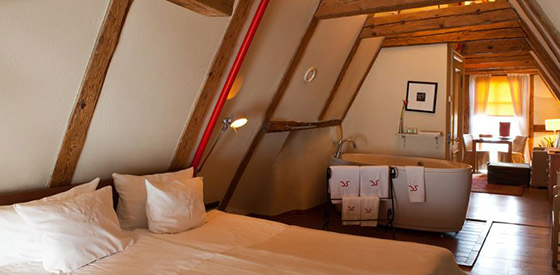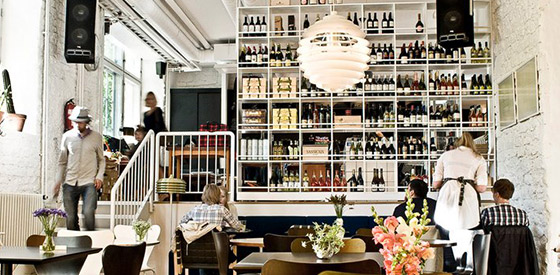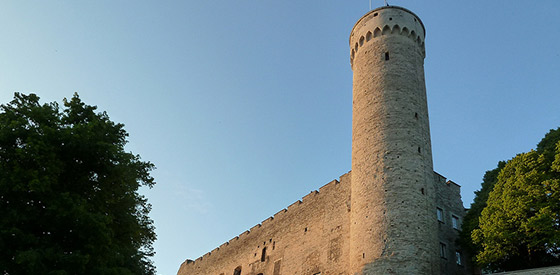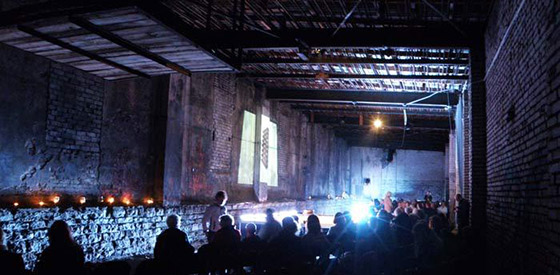1. Where to Stay

Sleep in luxury at The Three Sisters (from $306), Estonia’s only member of the Relais & Châteaux group. Built across three neighboring 14th-century merchant houses on Tallinn’s medieval main drag, Pikk (Long) Street, this hotel still boasts reminders of its centuries-long history, from the wooden crane once used to lift supplies to the upper floors to the original ceiling frescoes, unearthed beneath 14 layers of paint and wallpaper during the 2003 restoration. The 23 rooms are decidedly modern, each done up in a unique style: some with Nordic-inspired, blond-wood furnishings, others with curtain-draped canopy beds and freestanding bathtubs. Relax by the lobby’s wood-burning fireplace or in the cobblestone courtyard garden, and end the day in the cellar Beluga Bar, where czarist-era indulgences like caviar, cigars, and crisp, cold Russian vodka are on offer.
Enjoy the view of Tallinn’s historic Old Town at the Hotel Telegraaf (from $201). Dating back to 1878, this elegant building became the city’s post office and telegraph center upon the 1918 founding of the independent Republic of Estonia. The 86 refined rooms boast high ceilings, subtle Art Deco and historical touches (antique phones), and tiled soaking tubs perfect for relaxing tired limbs after a day traversing the city. Try dinner at the on-site French-Russian fusion restaurant Tchaikovsky, where chef de cuisine Vladislav Djatšuk, a finalist in the gastronomic Olympics known as the Bocuse d’Or, crafts intricate dishes like roasted-pigeon fillet and cabbage rolls of pigeon confit with parsnip and pomegranate sauce ($34).
Kick back in the cozy, 37-room Merchants House Hotel (from $104), built in the shell of neighboring 14th- and 16th-century buildings on a narrow cobblestone street just off of the town square. With chalky limestone walls, crackling antique fireplaces, twisty passageways and beamed ceilings, the space feels straight out of Shakespeare or Chaucer, but the amenities are decidedly contemporary: sleekly simple furnishings, exposed brick walls, and spacious bathrooms with basin sinks and claw-foot tubs. Relax with a steam in the on-site sauna or a treatment at the hotel spa, such as hot-chocolate or warm-honey massages (from $83) and Dead Sea salt exfoliation therapy ($87). Then cool off with a cocktail (from $6) served in a hand-molded ice glass at the lobby Ice Bar.
2. Where to Eat

Soak up the sun at Sfäär, a bistro/boutique inside a repurposed warehouse and former casino in the Rotermann Quarter. The space, with whitewashed limestone walls, is as much about food as design, with furnishings by Scandinavian mid-century modernists like Alvar Aalto, Arne Jacobsen, Ilmari Tapiovaara, and Louis Poulsen, and even charmingly curated knickknacks on the shelves like a plush cartoon rabbit from the Netherlands and minimalist Swedish cars and sailboat toys. The approachable bistro fare draws on the same clean, uncluttered Nordic inspirations: Try dishes like smoked pork tenderloin with celeriac potato cakes, cardamom-baked apples, and plum sauce ($17) or warm trout salad with poached eggs, panfried potatoes, and tarragon mayo ($12). Don’t just leave after your meal’s finished: Up a short flight of stairs and tucked behind a wall of wine bottles, you’ll find a designer concept store, selling everything from boots and backpacks to stationery and artisan bath products, from cutting-edge international brands like Sweden’s Acne jeans and Denmark’s Wrenchmonkees.
Embrace the blend of contemporary and traditional Estonian culture at Kaerajaan. It’s located in Old Town Square but there’s no medieval kitsch here—just breezy modern décor drawing on rural influences, such as lamps wrapped in hand-knit cardigans and mittens, centerpieces made from bundles of grain, and brightly patterned wall art based on folk embroidery patterns. The menu skews hearty and local, with dishes like wild elk from the forests of Western Estonia, served with buckwheat noodles and juniper berry sauce ($23). For a truly Baltic taste experience, don’t miss the rye-based desserts, like rye relish with rhubarb cream, meringue, and wild-raspberry sauce ($7) or rye mousse with cowberry icing, honey-caramelized rye, and anise syrup ($7).
Taste the spoils of the Baltic Sea and its surroundings at Neh, run by chefs Yves Le Lay and Maido Maiste (of Muhu Island’s Pädaste Manor). The cuisine here leans toward the hyperlocal focus of current Scandinavian chefs like René Redzepi with dishes adopting flavors and inspiration from the islands dotting the Baltic, such as Sweden’s Gotland and Öland, Denmark’s Bornholm, Finland’s Åland, and Estonia’s Saaremaa and Hiiumaa. Many of the ingredients (moose, boar, hand-gathered mushrooms and berries) come directly from the roughly 79 square miles of Estonia’s Muhu Island, or from neighboring islands, as in the grilled lamb heart from Saaremaa’s Sarapiku Farm, served with Brussels sprouts, cauliflower, and pearl onions ($26). Don’t miss the Made in Muhu platter, an appetizer for two containing a rotating lineup of island tastes like smoked moose, cured venison, and pickled herring ($25).
3. What to Do

Trace centuries of Estonian art at Kumu ($8), the country’s first purpose-built museum. Take a minute before entering to appreciate the building itself: Designed by Finnish architect Pekka Juhani Vapaavuori, the semicircular limestone-and-copper structure juts out of a rocky cliff in leafy Kadriorg Park. Start inside in the “Treasury” collection, which follows Estonia’s progression from classical painting through the birth of modernism, in works by nationalist portrait artist Johann Köler, expressionist Kristjan Raud, and Cézanne-like landscape painter Konrad Mägi. Advance to the socialist-realist work in the Difficult Choices gallery, which begins abruptly with the end of World War II and the start of Soviet occupation, then continue through the rest of the hall to learn how Estonian artists eventually experimented with modernism, Pop Art, and hyper-realism, blossoming into a post-Soviet future. Contemplate the country’s complex past at Villu Jaanisoo’s 2006 installation The Seagull, a powerful collection of 87 busts of historical figures displayed as an imposing terracotta army of sorts, spilling up an atrium wall, backed by a soundtrack of their overlapping voices.
Explore a century of national design history at the Estonian Museum of Applied Art and Design ($6), which houses a collection of nearly 15,000 works ranging from textiles, glass, and ceramics to furniture and product packaging. Though most of the objects on display are contemporary, you’d never know it from the surroundings: The museum is tucked away in a hidden courtyard in a former granary built between 1683 and 1695, and the galleries sit under medieval vaulted ceilings. Be sure to check out not only the permanent collection but the rotating exhibits, with current and upcoming shows dedicated to Nordic jewelry, contemporary blacksmithing, and industrial designer Tõnis Käo. After exploring the museum, be sure to pick up a Tallinn Design Map, a helpful guide to other notable galleries, boutiques, museums, and cafés in the city.
Hunt for locally made crafts at Tali, a design boutique that opened in 2012 on a tiny street in Old Town. Owner and local jeweler Triinu Tiisel’s expertly curated selection of objects ranging from jewelry and toys to textiles and clothing is a welcome, offbeat addition to the more touristy town center. Peruse the selection of Tiisel’s own delicate, feminine creations made with natural materials like wood, copper, quartz, and leather in an on-site workshop (jewelry $14 to $90). Other items may skew twee, but they’re no less tempting: the needle-felted plushes and brooches of Ksenia Matuzova’s Funky Sheepy brand, including penguins, bunnies, and gingerbread men (brooches $25), for example, or illustrator Ulla Saar’s cards, prints, and textiles, decorated with Wes Andersonian creatures like a kitten in a sensible scarf, a sleepwalking bear, and owls with spectacles (postcards $2).
4. Insider’s Tip

Tallinn is an astonishingly well-preserved medieval city with a storybook skyline of steeples, spires, and red roofs. Toompea (Cathedral Hill), a limestone plateau rising over the Old Town, is well known for its onion-domed Alexander Nevsky Cathedral and pink Baroque parliament building—less so for the various viewing platforms tucked around its edges, each offering a unique panorama of the town below. From the Kohtuotsa viewing platform on the northeastern side of the hill, you’ll get the best photographs of Old Town’s many spires; the Patkuli viewing platform, reachable by a staircase leading up from Toompark to the northernmost tip of Toompea, puts you up close and personal with the photogenic fortified medieval city wall and cone-topped towers; and the Piiskopi viewing platform, right behind the Cathedral of St. Mary the Virgin in what was once the bishop’s garden, looks out over the green Toompark, its snaking Snelli Pond, and the burgeoning Kalamaja District.
5. Oddball Day

Escape Tallinn’s fairy-tale Old Town with a tour of the grittier, more bohemian neighborhoods along the post-industrial waterfront. Grab eggs Benedict with roasted tomatoes for breakfast ($5.50) at Klaus Kohvik, a retro cafe at the Estonian Design House, which opened in 2010 in a repurposed limestone building at the old fishing port. You’ll still find fishermen selling shark fins and monkfish across the street each Saturday. Walk along Kalasadama until you reach the pedestrian and bike path known as the Culture Kilometer, which opened in 2011 in time for the city’s turn as the European Capital of Culture. Look out for EKKM: The Museum of Contemporary Art of Estonia, opened by squatters in the former Tallinn Heating Company building, and the Culture Cauldron, an avant-garde art space and theater in an old power plant. Turn right on Culture Kilometer and walk ten minutes until you reach the Patarei Sea Fortress Prison, which began life in 1840 as a fortress, commissioned by Czar Nicholas I, then became barracks, a Soviet prison, and, finally, a culture park. Next, stop into Lennusadam Seaplane Harbour ($14), a maritime museum that opened in May 2012 in an 1916 hangar that now houses a 600-ton submarine from 1936 and a 1550 shipwreck. Outside, don’t miss the world’s largest pre-war icebreaker before a lunch of smoked-pig-ear salad ($8) at museum cafe MARU. Retrace Culture Kilometer until it crosses Suur-Patarei and make a sharp right onto Vana-Kalamaja. Along the way, admire the colorful “Tallinn Houses” that define the neighborhood of Kalamaja—wooden boardinghouses built in the 1920s to house factory workers, now popular with artists and hipsters. Take a break at Kalma Sauna, the city’s oldest bathhouse, which opened in 1928 and still uses wood-burning fires (men from $11, women from $9). Follow Vana-Kalamaja until it becomes Kopli, then take a slight left onto Telliskivi. In 15 minutes, you’ll reach Telliskivi Loomelinnak, a new urban-renewal project that transformed the Baltic Railway factory into bars, restaurants, and shops. Cross the street for dinner at Bar Bistro Kukeke, an airy cafe located in a 19th-century railway depot—try the Liivimaa steak with fried mushrooms and onions in a creamy truffle sauce ($19)—then end the night with a pint of locally brewed Õllenaut smoked porter ($5) at Estonia’s first craft-beer bar, Pudel.
6. Links
Explore dining recommendations on Flavours of Estonia’s annual 50 Best Restaurants list.
Read about local news, politics, and current events on Postimees, the largest daily newspaper in the Baltics.
Keep up to date on concerts, gallery shows, and theater productions with KultuuriKatel.
Find daily cultural events on Culture.ee.